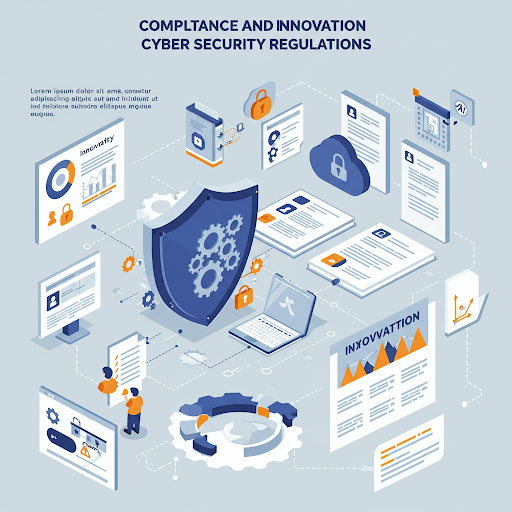In today’s rapidly evolving digital landscape, cybersecurity is no longer a backroom IT concern it’s a strategic priority. As cyber threats grow more sophisticated, governments and industries worldwide are racing to implement cybersecurity regulations to protect sensitive data and critical infrastructure.
But here’s the challenge: while these regulations are essential for national security and consumer protection, too much rigidity can stifle innovation. Striking the right balance between compliance and innovation is crucial not just for keeping systems secure, but for fostering a tech-driven economy that thrives.
This blog explores how organizations can walk the fine line between regulatory compliance and technological innovation, offering insights for security professionals, policy makers, and forward-thinking businesses.
Table of Contents
Why Cybersecurity Regulations Exist (And Why They Matter)
Let’s start with the “why.”
Cybersecurity regulations are designed to ensure organizations adopt minimum security standards to safeguard:
-
Personal data (e.g., GDPR in Europe)
-
Financial systems (e.g., GLBA in the U.S.)
-
Healthcare systems (e.g., HIPAA)
-
Critical infrastructure (e.g., NIST, CISA frameworks)
These laws create accountability, transparency, and structure all vital in a world where a single breach can cost millions and erode public trust.
But what happens when security mandates become too prescriptive? Organizations may hesitate to implement emerging tech, fearing non-compliance. In worst cases, businesses fall behind in innovation—and ironically, become more vulnerable as a result.
The Innovation Trap: When Compliance Hinders Progress
Cybersecurity compliance frameworks are often built to address known threats. However, cyber risks evolve quickly much faster than legislation can keep up.
Here’s the issue:
-
Regulations may dictate the use of outdated technologies or rigid protocols.
-
Startups and innovators may lack resources to meet exhaustive compliance checklists.
-
Rapid innovators (especially in AI, IoT, and cloud) may face uncertainty about how regulations apply to new models and tools.
The result? Fear-driven stagnation.
Compliance is essential, yes but it should not become a barrier to exploring more secure, efficient, or intelligent solutions.
Innovation Can Enhance Compliance
The good news: compliance and innovation don’t have to be opposites. When aligned correctly, innovation can actually enhance regulatory adherence.
Here are a few examples:
-
AI-powered threat detection systems outperform traditional security tools and can support real-time compliance monitoring.
-
Blockchain technology can improve data integrity and auditing, meeting regulatory demands for transparency.
-
Zero Trust frameworks align with many modern compliance standards and improve enterprise security posture.
When organizations use innovation strategically, they can future-proof compliance, rather than just reacting to the latest rules.
Frameworks That Encourage Both Security and Innovation
Fortunately, not all regulations are inflexible. Some frameworks are risk-based and adaptive, allowing room for innovation:
-
NIST Cybersecurity Framework (CSF): Encourages organizations to assess risk and apply controls flexibly.
-
ISO/IEC 27001: Offers a principles-based approach to securing information assets while supporting scalability.
-
GDPR (when interpreted wisely): Promotes privacy-by-design, which can inspire creative, user-first innovations.
These frameworks provide guidance, not blueprints giving organizations the chance to secure their systems in ways that fit their architecture and culture.
Best Practices for Balancing Compliance and Innovation
Struggling to navigate the tightrope? Here are proven strategies that help organizations maintain cybersecurity compliance while embracing innovation:
1. Shift From “Check-the-Box” to Risk-Based Mindsets
Compliance shouldn’t be about ticking boxes. Adopt a risk-based approach, focusing on protecting assets, data flows, and user behavior over meeting technicalities.
2. Build Compliance Into the Innovation Lifecycle
Whether you’re developing a new app, deploying AI tools, or migrating to cloud-native infrastructure integrate compliance into the design process, not after the fact.
3. Use DevSecOps Principles
Combine development, security, and operations in a seamless workflow. Automate policy enforcement, code reviews, and penetration testing from the start.
4. Leverage Smart Tools
Use platforms that automate compliance reporting, policy updates, and real-time monitoring. Innovation doesn’t mean cutting corners. it means doing smarter work with better tools.
5. Collaborate With Regulators
Engage with policy makers through working groups or industry roundtables. Share your innovation challenges many agencies are willing to listen and adapt.
Real-World Example: A Healthcare Startup Navigates HIPAA With Innovation
A digital health startup wanted to use AI to analyze patient symptoms via chat. But they faced a wall of HIPAA compliance hurdles, especially around patient data and third-party cloud services.
Instead of ditching the project, they:
-
Hired a virtual CISO early in development.
-
Built their app on a HIPAA-compliant cloud platform with built-in encryption.
-
Implemented user consent flows designed around privacy-by-design principles.
-
Created audit logs and reporting tools from day one.
They launched a secure, scalable, and compliant platform—and now lead the market in patient engagement innovation.
Key takeaway: Smart, early integration of compliance can empower innovation not block it.
The Role of Regulators: Enabling Secure Innovation
Regulators also have a part to play. The goal should be to establish guardrails, not roadblocks.
Forward-thinking governments and agencies are now:
-
Issuing regulatory sandboxes to test new tech in a controlled environment (e.g., UK’s FCA sandbox).
-
Publishing interpretation guides for applying old rules to new tech (e.g., NIST AI Risk Framework).
-
Encouraging public-private partnerships to co-develop adaptive security standards.
This signals a shift toward agile regulation where innovation isn’t punished but nurtured securely.
Conclusion: Compliance + Innovation = Future-Ready Security
Cybersecurity doesn’t exist in a vacuum. Regulations keep us safe, but innovation pushes us forward.
Organizations that thrive in today’s climate are those that understand:
-
Compliance is necessary, but not enough.
-
Innovation is risky, but unavoidable.
-
The sweet spot is where security, flexibility, and creativity intersect.
By investing in culture, collaboration, and modern frameworks, businesses can achieve cybersecurity compliance without slowing down innovation.
Because in a world where cyber threats evolve daily, the most secure organizations aren’t just compliant they’re resilient, responsive, and always evolving.
Read More – cybersecurity compliance and innovation

